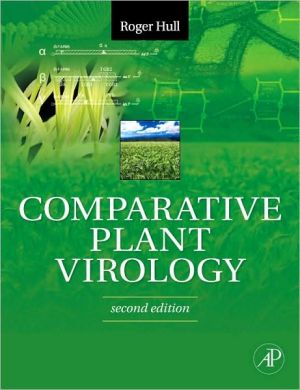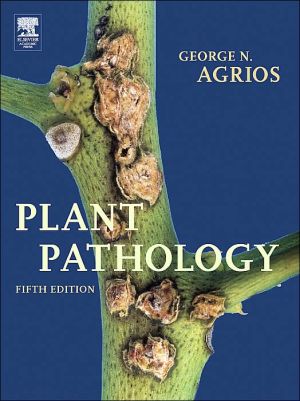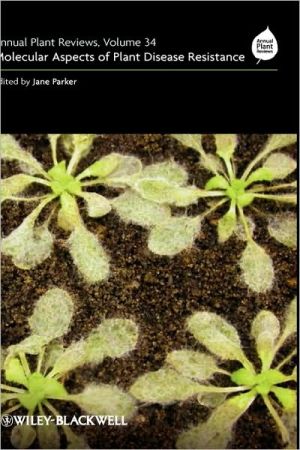Comparative Plant Virology
Comparative Plant Virology provides a complete overview of our current knowledge of plant viruses including background information on plant viruses and up-to-date aspects of virus biology and control. It deals mainly with concepts rather than detail. The focus will be on plant viruses but due to the changing environment of how virology is taught, comparisons will be drawn with viruses of other kingdomes, animals, fungi and bacteria. It has been written for students of plant virology, plant...
Search in google:
Comparative Plant Virology provides a complete overview of our current knowledge of plant viruses including background information on plant viruses and up-to-date aspects of virus biology and control. It deals mainly with concepts rather than detail. The focus will be on plant viruses but due to the changing environment of how virology is taught, comparisons will be drawn with viruses of other kingdomes, animals, fungi and bacteria. It has been written for students of plant virology, plant pathology, virology and microbiology who have no previous knowledge of plant viruses or of virology in general.• Boxes highlight important information such as virus definition and taxonomy.• Includes profiles of 32 plant viruses that feature extensively in the text• Companion website providng image bank• Full colour throughout
COMPARATIVE PLANT VIROLOGY\ \ By Roger Hull \ Academic Press\ Copyright © 2009 Elsevier Inc.\ All right reserved.\ ISBN: 978-0-08-092096-2 \ \ \ Chapter One\ What Is a Virus? \ This chapter discusses broad aspects of virology and highlights how plant viruses have led the subject of virology in many aspects.\ OUTLINE I. Introduction 3\ II. History 3\ III. Definition of a Virus 9\ IV. Classification and Nomenclature of Viruses 13\ V. Viruses of Other Kingdoms 20\ VI. Summary 21\ I. INTRODUCTION\ Plant viruses are widespread and economically important plant pathogens. Virtually all plants that humans grow for food, feed, and fiber are affected by at least one virus. It is the viruses of cultivated crops that have been most studied because of the financial implications of the losses they incur. However, it is also important to recognise that many "wild" plants are also hosts to viruses. Although plant viruses do not have an immediate impact on humans to the extent that human viruses do, the damage they do to food supplies has a significant indirect effect. The study of plant viruses has led the overall understanding of viruses in many aspects.\ II. HISTORY\ Although many early written and pictorial records of diseases caused by plant viruses are available, they are do not go back as far as records of human viruses. The earliest known written record of what was very likely a plant virus disease is a Japanese poem that was written by the Empress Koken in A.D. 752 and translated by T. Inouye:\ In this village It looks as if frosting continuously For, the plant I saw In the field of summer The colour of the leaves were yellowing\ The plant, which has since been identified as Eupatorium lindleyanum, has been found to be susceptible to Tobacco leaf curl virus, which causes a yellowing disease.\ In Western Europe in the period from about 1600 to 1660, many paintings and drawings were made of tulips that demonstrate flower symptoms of virus disease. These are recorded in the Herbals of the time and some of the earliest in the still-life paintings of artists such as Ambrosius Bosschaert. During this period, blooms featuring such striped patterns were prized as special varieties, leading to the phenomenon of "tulipomania" (Box 1.1).\ Because of their small genomes, viruses have played a major role in elucidating many of the concepts in molecular biology, and the study of plant viruses has produced several of the major findings for virology in general. The major steps in reaching the current understanding of viruses are shown in the timeline in Figure 1.1.\ Details of these "breakthroughs" can be found in Hull (2002; plant viruses), Fenner, (2008; vertebrate viruses), and Ackermann (2008; bacterial viruses). Plant viruses played a major role in determining exactly what a virus was. In the latter part of the nineteenth century, the idea that infectious disease was caused by microbes was well established, and filters were available that would not allow the known bacterial pathogens to pass through. In 1886, Mayer (see Figure 1.2A) described a disease of tobacco that he called Mosaikkrankheit, which is now known to be caused by the Tobacco mosaic virus (TMV). Mayer demonstrated that the disease could be transmitted to healthy plants by inoculation with extracts from diseased plants. A major observation was made in 1892 by Iwanowski, who showed that sap from tobacco plants displaying the disease described by Mayer was still infective after it had been passed through a bacteria-proof filter candle. However, based on previous studies, it was thought that this agent was a toxin. Iwanowski's experiment was repeated in 1898 by Beijerinck (see Figure 1.2B), who showed that the agent multiplied in infected tissue and called it contagium vivum fluidum (Latin for "contagious living fluid") to distinguish it from contagious corpuscular agents (Figure 1.2C).\ Beijerinck and other scientists used the term virus to describe the causative agents of such transmissible diseases to contrast them with bacteria. The term virus had been used more or less synonymously with bacteria by earlier workers, but as more diseases of this sort were discovered, the unknown causative agents came to be called "filterable viruses." Similar properties were soon after reported for some viruses of animals (e.g., the filterable nature of the agent causing foot and mouth disease in 1898) and of bacteria in 1915. Over the course of time, the word filterable has been dropped, leaving just the term virus.\ As shown in the timeline in Figure 1.1, in the subsequent development of virology, many of the studies ran in parallel for viruses of plants, vertebrates, invertebrates, and bacteria. In fact, when viewed overall, there is evidence of much cross-feeding between the various branches of virology. However, there were differences mainly due to the interactions that these viruses have with their hosts. For instance, vertebrates produce antibodies that counter viruses, whereas plants, invertebrates, and bacteria do not. Another factor that has contributed to advances is the simplicity of the system exemplified by studies on bacteriophage being linked to studies on bacterial genetics.\ The development of plant, and other, virology can be considered to have gone through five major (overlapping) ages. The first two, Prehistory and Recognition of viral entity, were just described. After these two came the Biological age, between 1900 and 1935, when it was determined that plant viruses were transmitted by insects and that some of these viruses multiplied in, and thus were pathogens of, insects in a manner similar to some viruses of vertebrates. One of the constraints to plant virology was the lack of a quantitative assay, until Holmes in 1929 showed that local lesions produced in some hosts after mechanical inoculation could be used for the rapid quantitative assay of infective virus. This technique enabled properties of viruses to be studied much more readily and paved the way for the isolation and purification of viruses a few years later.\ The Biochemical/Physical age started in the early 1930s. The high concentration at which certain viruses occur in infected plants and their relative stability was crucial in the first isolation and chemical characterisation of viruses because methods for extracting and purifying proteins were not highly developed. In 1935, Stanley announced the isolation of this virus in an apparently crystalline state but considered that the virus was a globulin containing no phosphorus. In 1936, however, Bawden and his colleagues described the isolation from TMV-infected plants of a liquid crystalline nucleoprotein containing nucleic acid of the pentose type. Around 1950, Markham and Smith showed that the RNA of Turnip yellow mosaic virus was encapsidated in a protein shell and was important for biological activity. This led to the classic experiments of Gierer, Schramm, Fraenkel-Conrat, and Williams in the mid-1950s that demonstrated the infectivity of naked TMV RNA and the protective role of the protein coat.\ In parallel with these biochemical studies, physical studies in the late 1930s using X-ray analysis and electron microscopy confirmed that TMV had rod-shaped particles and obtained accurate estimates of the size of the rods. Attention turned to the structure of these particles, and in 1956, Crick and Watson suggested that the protein coats of small viruses are made up of numerous identical subunits arrayed either as helical rods or as a spherical shell with cubic symmetry. This led to Caspar and Klug (1962) formulating a general theory that delimited the possible numbers and arrangements of the protein subunits forming the shells of the smaller isodiametric viruses (see Chapter 5). Our recent knowledge of the larger viruses with more complex symmetries and structures has come from electron microscopy using negative-staining and ultrathin-sectioning methods.\ The current Molecular age started in about 1960 when the full sequence of 158 amino acids in the coat protein of TMV was determined. The sequence of many naturally occurring strains and artificially induced mutants was also determined at about the same time. This work made an important contribution to establishing the universal nature of the genetic code and to our understanding of the chemical basis of mutation. This age continued with the sequencing of representatives of most, if not all, virus genera leading to a greater understanding of how viruses function and interact with their hosts. The results from these studies are described in detail in this book and in the suggested further reading.\ III. DEFINITION OF A VIRUS\ A. How Viruses Differ from Other Plant Pathogens\ In the size of their nucleic acids, viruses range from a monocistronic mRNA in the satellite virus of tobacco necrosis virus (STNV) to a genome larger than that of the smallest cells (Figure 1.3). A biologically more meaningful way of comparing genome sizes is to consider the information content—that is, the number of genes that they contain; some examples are given in Table 1.1. Before attempting to define what viruses are, we must consider briefly how they differ from other entities such as cellular parasites, plasmids, and transposable genetic elements. The three simplest kinds of parasitic cells are the Mycoplasmas, the Rickettsiae, and the Chlamydiae.\ Mycoplasmas and related organisms are not visible by light microscopy. They are 150–300 nm in diameter with a bilayer membrane but no cell wall, and they contain RNA along with ribosomes and DNA. They replicate by binary fission, and some that infect vertebrates can be grown in vitro. Their growth is inhibited by certain antibiotics. Some mycoplasmas are plant pathogenic (see Chapter 3).\ The Rickettsiae, for example, the agent of typhus fever, are small, nonmotile bacteria, usually about 300 nm in diameter. They have a cell wall, plasma membrane, and cytoplasm with ribosomes and DNA strands. They are obligate parasites and were once thought to be related to viruses, but they are definitely cells because they multiply by binary fission, and they contain enzymes for ATP production.\ The Chlamydiae, for example, the agent that causes psittacosis, include the simplest known type of cell. They are obligate parasites that grow by infecting eukaryotic cells and lack an energy-generating system. They are as small as, or smaller than, many viruses. Chlamydiae have two phases to their life cycle. Inside host cells they take on an intracellular replicative form (termed the reticulate body) and rely on the host cell energy-yielding system; outside the cell they survive by forming infectious elementary bodies about 300 nm in diameter, which is smaller than some pox viruses. Chlamydiae can be grown only where their host cells grow and cannot be propagated in bacterial culture media.\ Several criteria do and do not distinguish all viruses from all cells (see Table 1.2).\ Plasmids are autonomous extrachromosomal genetic elements found in many kinds of bacteria. They consist of closed circular DNA. Some can become integrated into the host chromosome and replicate with it. Some viruses that infect prokaryotes have properties like those of plasmids and, in particular, the ability to integrate into the host cell chromosome. However, viruses differ from plasmids in the following ways:\ 1. Normal viruses have a particle with a structure designed to protect the genetic material in the extracellular environment and to facilitate entry into a new host cell.\ 2. Virus genomes are highly organised for specific virus functions of no known value to the host cell, whereas plasmids consist of genetic material that is often useful for the survival of the cell.\ 3. Viruses can kill cells or cause disease in the host organism, but plasmids cannot.\ (Continues...)\ \ \ \ \ Excerpted from COMPARATIVE PLANT VIROLOGY by Roger Hull Copyright © 2009 by Elsevier Inc.. Excerpted by permission of Academic Press. All rights reserved. No part of this excerpt may be reproduced or reprinted without permission in writing from the publisher.\ Excerpts are provided by Dial-A-Book Inc. solely for the personal use of visitors to this web site. \ \
Ch.1 What Is a Virus?Ch. 2 Overview of Plant VirusesCh. 3 Agents That Resemble or Alter Plant Virus DiseasesCh. 4 Plant Virus Origins and EvolutionCh. 5 Architecture and Assembly of Virus ParticlesCh. 6 Plant Viral GenomesCh. 7 Expression of Viral GenomesCh. 8 Virus ReplicationCh. 9 Virus-Host Interactions - Plant LevelCh. 10 Virus-Plant Interactions: 1. Molecular LevelCh. 11 Virus-Plant Interactions: 2. RNA SilencingCh. 12 Plant-to-Plant MovementCh. 13 Plant Viruses in the Field: Diagnosis, Epidemiology, and EcologyCh. 14 Conventional ControlCh. 15 Transgenic Plants and VirusesApp ProfilesIndex







